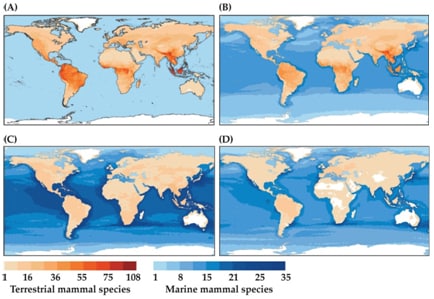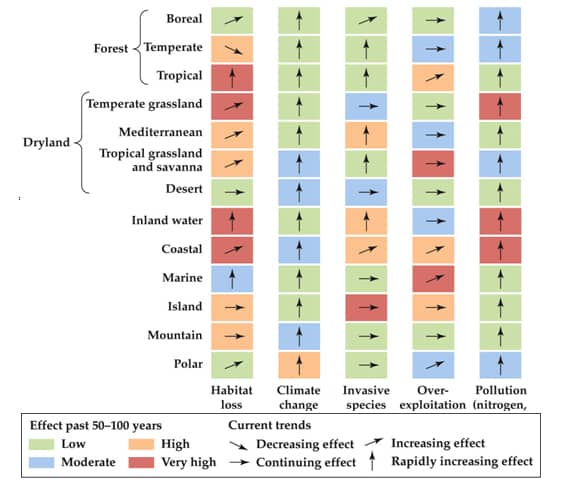- As the human population has grown, and our use of resources has increased, we have destroyed the habitat of many species.
- A biodiversity crisis has developed.
- The Red List of Threatened Species, compiled by the World Conservation Union, lists 16,913 species as threatened with extinction.
Conservation biology—the scientific study of phenomena that affect the maintenance, loss, and restoration of biodiversity.
- Conservation biology is an integrative discipline that applies the principles of ecology to the protection of biodiversity.
- Stabilization of populations requires expertise from several biological disciplines, as well as law, political science, and sociology.
- Conservation biology is a value-based discipline.
- The scientific method calls for objectivity—collection and interpretation of data without bias.
- But it is not free of human values, and takes place within a larger social context.
- Biodiversity is declining globally.
- Rates of extinction are difficult to measure because the number of species on Earth currently is unknown.
- Extinction rates determined from the fossil record are used as background rates.
- For mammals and birds, the background rate is one species every 200 years.
- Overall, extinction rate in the twentieth century was 100 to 1,000 times higher than the background rate.
Estimates of current extinction rates rely on:
- The species–area relationship.

- Changes in the threat status of species (e.g., shift from endangered to critically endangered).
- Rates of population decline or range contraction of common species.
- Declaring a species extinct can stimulate biologists’ search efforts.
- Humans have always had a large impact on other species.
- Most of the species were endemic. Some entire guilds went extinct, which must have caused large community changes.
- Much research on extinction has focused on problems of small populations, which are vulnerable to genetic, demographic, and environmental events.
- Extinction vortex: A small population declines even further and becomes ever more vulnerable to processes that lead to extinction.
- A spatial approach tracks changes in species’ ranges
- Decrease in generalist pollinators showed the greatest effect.
- The movement and introduction of species to all parts of the globe has increased greatly over the last century.
- The range expansion of some species has coincided with range contraction of many native species.
- The greatest “losers” among native species tend to be specialists with adaptations that resulted from evolution in a particular place.
- The “winners” tend to be generalists with less stringent habitat requirements.
- The spread of introduced species and native generalists, and the decline of native specialists, is leading to taxonomic homogenization of Earth’s biota. [Same species found all across the globe; primarily generalist, not specialists.]
- Genetic homogenization is also occurring through hybridization between native and non-native species. However the native species of an environment will be overrun by that of the non-native species.
Threats to Biodiversity
Primary threats to biodiversity include habitat loss, invasive species, overexploitation, pollution, disease, and climate change.
Understanding the causes of biodiversity loss is the first step toward reversing them.
- Multiple factors are likely to contribute to decline and extinction of a species.

- A) Habitat Loss
- B) Invasive Species
- C) Overexploitation
- D) Pollution
- Human activities are by far the most important factor contributing to global declines in biodiversity.
- Habitat loss—conversion of an ecosystem to another use.
- Habitat fragmentation—breaking up continuous habitat into patches amid a human-dominate landscape.
- Habitat degradation—changes that reduce quality of the habitat for many, but not all, species.
- Marine life may be brought aboard, called bycatch.
- Bycatch includes many species of concern, including marine mammals, birds, and turtles.
- Overharvesting of resources such as wood, fiber, oils, and medicines has also threatened many species.
Approaches to Conservation
Conservation biologists use many tools and work at multiple scales to manage declining populations.
Two approaches to conservation planning:
- Fine-filter (genes/populations/species).
- Coarse-filter (landscape/ecosystem/ habitat)—emphasis on maintaining ecosystem processes; protects many species at once.
- Small populations are vulnerable to genetic drift and inbreeding, which can result in the loss of genetic variability and fixation of deleterious alleles.
- These effects increase the risk of extinction, and can ruin efforts to conserve a species
- Sometimes, a “genetic rescue” is attempted; introduction of similar hybrids from other populations or from different metapopulations.
- In some cases, the only hope for extremely small populations may be to remove the species from its habitat and propagate it in sheltered conditions (ex situ).
- Genetic analyses are also being used to identify evolutionarily significant units—appropriate targets for management within species (e.g., subspecies or populations).
Ranking Species for Protection
- Prioritizing species helps maximize the biodiversity that can be protected with limited resources.
- Some species may be naturally rare.
- Rarity depends on geographic range, habitat specificity, and population sizes.
- This results in different types of rarity. Conservation of these different types of rare species requires different approaches.
- Protecting habitat for one species, such as the red-cockaded woodpecker, can result in protection of other species as well. These are called surrogate species. A species selected as a priority for conservation with the assumption that its conservation will serve to protect many other species with overlapping habitat requirements.
- This can be a shortcut when there is a lack of information about many species in an area.
- A flagship species is a charismatic organism that people will want to give protection to, such as the giant panda.
- Umbrella species: A surrogate species selected with the assumption that protection of its habitat will serve as an “umbrella” to protect many other species; often a species with large or specialized habitat requirements or one that is easy to count. Often large, specialized and esay to count.
- They usually have large ranges (grizzly bear) or specialized habitats (red-cockaded woodpecker), or are easy to count (butterflies).
- Several focal species group of species selected as a priority for conservation efforts, chosen because its ecological requirements differ from those of other species in the group, thereby helping to ensure that as many different species as possible receive protection.
- By casting a broader net, we improve the chances of protecting regional biodiversity.

